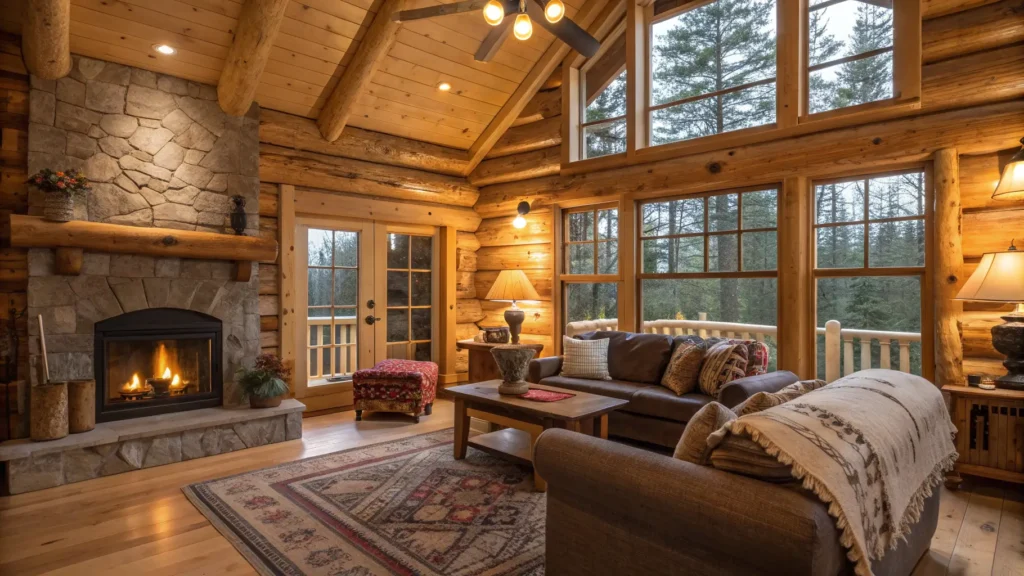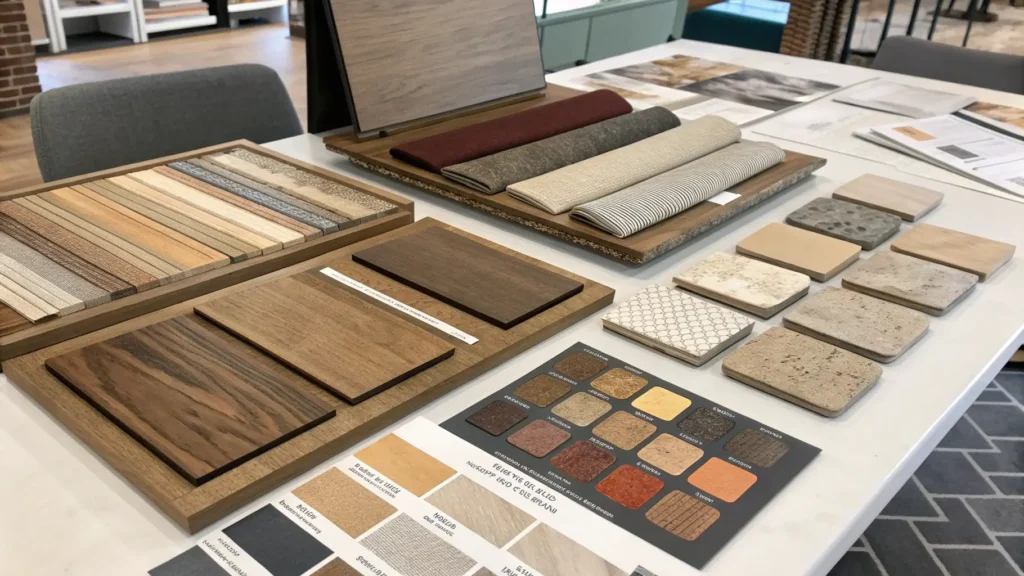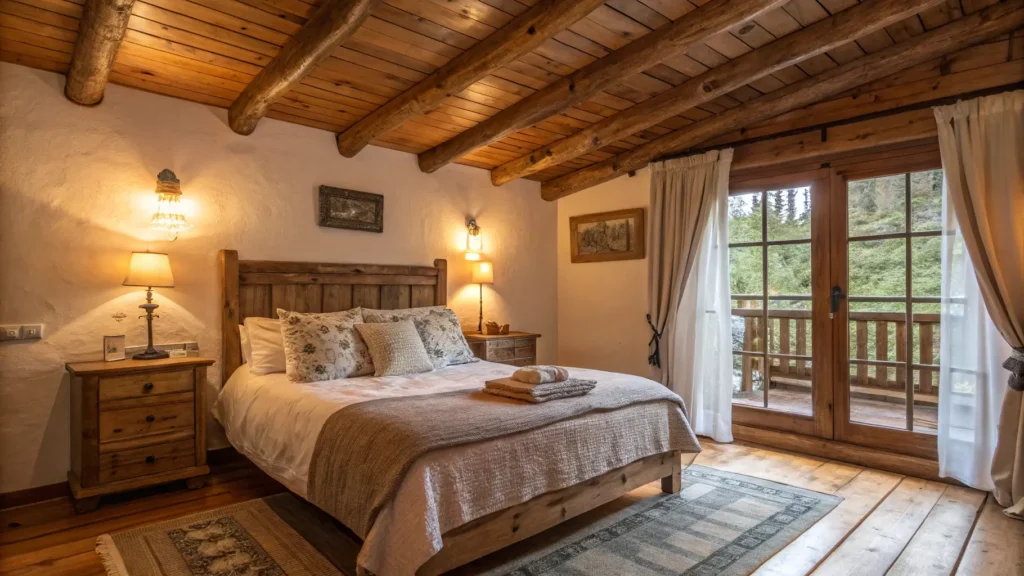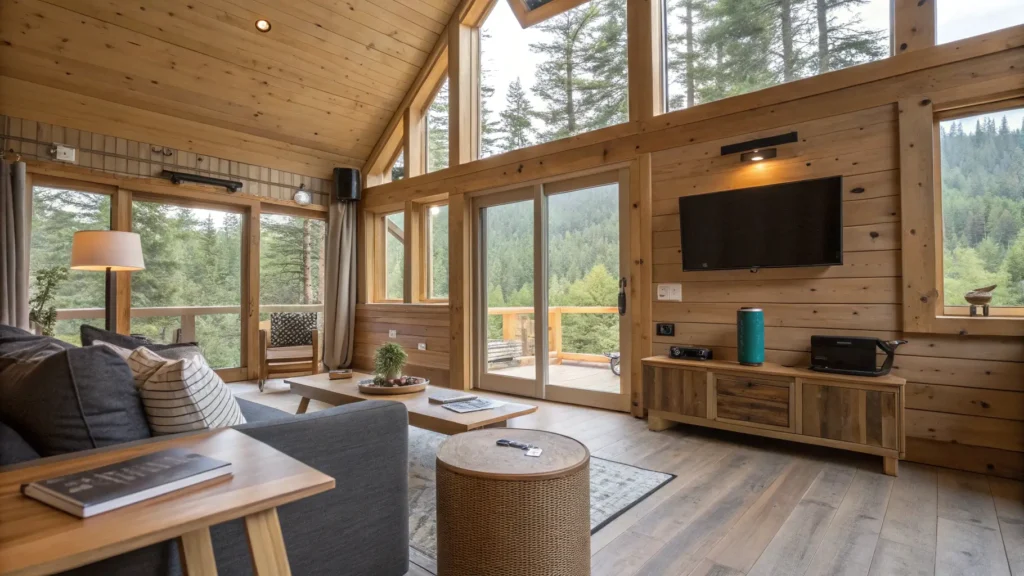Are you dreaming of a cozy retreat nestled in nature, but feel overwhelmed by the endless possibilities for its interior? From rustic charm to sleek modernism, cabin interior design offers a unique opportunity to blend comfort with the raw beauty of the outdoors. This guide is your ultimate resource, meticulously structured to help you navigate the diverse world of cabin aesthetics, offering unparalleled exploration and direct comparison of every popular style. We’ll provide expert tips, budget-friendly solutions, and actionable room-by-room advice, all presented with rich visuals to serve as the definitive planning resource for any cabin owner or enthusiast.

TABLE OF CONTENTS
Understanding Cabin Interior Design: More Than Just Four Walls
A cabin is more than just a structure; it’s an escape, a sanctuary, and a deep connection to nature. Understanding cabin interior design starts with grasping this fundamental essence. It’s about creating spaces that evoke comfort, tranquility, and a sense of belonging, whether nestled in mountains, by a lake, or deep in the woods.
The aesthetic of cabin living has evolved dramatically over time. What once solely defined a rustic log home now encompasses a spectrum of sophisticated styles, from traditional warmth to cutting-edge contemporary. Regardless of the chosen style, key elements like wood, stone, and an abundance of natural light remain central to the cabin experience. This guide will help you pinpoint the perfect design that captures the unique feeling and lifestyle you envision for your cabin.
Exploring Popular Cabin Interior Design Styles: Find Your Perfect Aesthetic
The beauty of cabin interior design lies in its versatility. There’s a style for every preference, each offering a distinct personality and ambiance. Discovering your perfect aesthetic is the first exciting step in transforming your cabin.
Rustic Cabin Interior Design: Embracing Timeless Charm
Rustic cabin interiors celebrate natural imperfections and raw beauty. This style is deeply rooted in tradition, favoring robust, handcrafted pieces and an organic connection to the environment. Think exposed wooden beams, stone fireplaces, and furniture made from reclaimed wood.
The defining characteristics include heavy, solid wood furniture, warm color palettes of earthy tones, and natural textures like wool, leather, and rough-hewn stone. It’s about creating a lived-in, authentic, and incredibly cozy atmosphere that feels deeply connected to its surroundings.
Modern Cabin Interior Design: Sleek Lines Meet Natural Beauty
Modern cabin interior design presents a striking contrast, blending contemporary aesthetics with the inherent natural beauty of a cabin. This style emphasizes clean lines, open spaces, and large windows that frame breathtaking outdoor views. It’s about sophistication without sacrificing warmth.
Materials like polished concrete, steel, and expansive glass are combined with natural wood and stone. The color palette often leans towards neutrals, with strategic pops of color, while furniture is typically minimalist and functional. The aim is a sleek, uncluttered, and highly functional retreat that still feels deeply connected to nature.

Scandinavian Cabin Interior Design: Hygge, Simplicity & Light
Inspired by Nordic principles, Scandinavian cabin interior design champions simplicity, functionality, and the concept of “Hygge”—a quality of coziness and comfortable conviviality. This style thrives on maximizing natural light, especially during long winters.
Key elements include light-colored woods (like birch and pine), a predominantly white or muted color palette, and minimal, highly functional furniture. Textures like wool, sheepskin, and linen add warmth, while subtle green plants bring the outdoors in. It’s about creating a bright, serene, and effortlessly comfortable space.
Farmhouse Cabin Interior Design: Cozy Comfort with a Homely Feel
Farmhouse style injects a sense of nostalgic comfort and homely warmth into a cabin setting. It’s less about ruggedness and more about inviting, lived-in charm, often with a touch of vintage flair. This style feels approachable and incredibly welcoming.
Think shiplap walls, distressed wood finishes, antique or vintage-inspired furniture, and a focus on practical, family-friendly pieces. Soft textiles, plaid patterns, and a mix of warm neutrals with accent colors like sage green or deep blue are common. It creates an atmosphere that feels both quaint and comfortable.
Mountain Lodge Interior Design: Grandeur, Warmth & Robustness
Mountain lodge cabin interior design evokes the grand scale and sturdy elegance of alpine retreats. This style leans into robust materials and a sense of grandeur, perfect for cabins set against dramatic natural backdrops. It’s about creating an impressive yet supremely comfortable haven.
Key features include large stone fireplaces, heavy timber beams, rich leather furniture, and deep, warm color palettes (burgundies, forest greens, deep blues). Antler decor, Pendleton blankets, and substantial furnishings are common, creating a luxurious, inviting, and durable aesthetic.
Luxury Cabin Interior Design: Bespoke Elegance in Nature
Luxury cabin interior design transcends specific styles, focusing on bespoke elegance, high-end finishes, and unparalleled comfort. This approach customizes every detail to create a unique, sophisticated retreat that offers an elevated experience in a natural setting.
This style often combines elements from modern or mountain lodge aesthetics but with a focus on custom craftsmanship, designer furnishings, and state-of-the-art amenities. Expect premium materials, integrated smart home technology, and personalized touches that define exclusivity and comfort. It’s about creating a five-star experience in the wilderness.
Small Cabin Interior Design: Maximizing Space & Style
Designing a small cabin requires clever strategies to maximize both functionality and aesthetic appeal. Small cabin interior design is about smart solutions that make compact spaces feel expansive, stylish, and highly livable.
Key strategies include multi-functional furniture, built-in storage, light color palettes to make rooms feel larger, and thoughtful use of mirrors to enhance depth. Vertical space is often utilized with shelving and tall, narrow pieces. Every item is chosen for purpose and visual impact, ensuring a clutter-free and inviting environment.
Comparing Cabin Interior Design Styles: Your Decision-Making Guide
Choosing the right cabin interior design style can feel daunting, but understanding their distinct characteristics makes the decision clearer. Our comprehensive comparison will highlight the differences, helping you select the aesthetic that best suits your vision and lifestyle.
| Style | Primary Materials | Typical Color Palette | Furniture Characteristics | Overall Ambiance | Budget Considerations |
|---|---|---|---|---|---|
| Rustic | Reclaimed wood, stone, leather | Earth tones, deep reds, greens | Heavy, handcrafted, antique-inspired | Cozy, authentic, rugged | Moderate (can DIY), can be expensive for high-end. |
| Modern | Wood, glass, steel, concrete | Neutrals, black, white, accent | Sleek, minimalist, functional | Sophisticated, clean, open | Moderate to high, depends on materials and tech. |
| Scandinavian | Light wood, wool, linen | White, grey, light pastels | Simple, functional, ergonomic | Bright, serene, cozy (“Hygge”) | Moderate, focus on quality over quantity. |
| Farmhouse | Distressed wood, shiplap, iron | Whites, creams, soft blues/greens | Vintage-inspired, comfortable, practical | Homely, inviting, nostalgic | Low to moderate (great for DIY, thrifting). |
| Mountain Lodge | Heavy timber, stone, leather | Rich browns, reds, greens, navy | Substantial, grand, durable | Luxurious, robust, imposing | High (requires significant structural/material investment). |
| Luxury | Bespoke, high-end materials | Custom, often refined neutrals | Designer, custom-made | Elegant, exclusive, indulgent | Very high (customization, premium materials). |
| Small Cabin | Light wood, multi-functional | Light neutrals, strategic accents | Compact, built-in, multi-purpose | Efficient, airy, smart | Varies, but smart choices save space and money. |
This table simplifies the complex choices involved in cabin interior design, providing a quick reference to align your preferences with the perfect style.
Cabin In The Woods 2.0 – An Architect’s Amazing Vision
Essential Elements & Materials for Your Dream Cabin Interior
Regardless of the chosen style, certain foundational elements are crucial for any successful cabin interior design. These materials and principles connect your space to its natural setting and establish a harmonious aesthetic.
The Dominance of Wood: Types, Finishes, Applications
Wood is the undisputed king of cabin interiors. Its versatility allows it to define the character of any space.
- Types: From rustic knotty pine and robust oak to elegant maple and light birch, the wood type dictates the mood.
- Finishes: A clear matte finish preserves natural beauty for a rustic look, while a high-gloss stain can lend a more refined or modern touch. Whitewashed or painted wood is common in Scandinavian and Farmhouse designs.
- Applications: Wood can grace floors, walls, ceilings (especially exposed beams), and all types of furniture.
Incorporating Stone & Other Naturals
Stone provides a grounding, earthy counterpoint to wood, adding texture and durability.
- Fireplaces: A stone fireplace is often the central focal point of a cabin living room.
- Accents: Stone can be used for accent walls, backsplashes in kitchens, or even as decorative elements on mantels.
- Other Naturals: Incorporate elements like river rocks, tree stumps used as side tables, or woven rattan for subtle texture.
Metals & Hardware: Wrought Iron, Copper, Bronze
Metals add character and structure. Wrought iron lends a traditional, robust feel, perfect for rustic or mountain lodge styles in lighting fixtures, railings, or furniture details. Copper and bronze can introduce warmth and a touch of antique elegance, ideal for kitchen hardware or accent pieces. In modern designs, sleek matte black or polished chrome might be preferred.
Textiles & Textures: Importance of Layers
Textiles are essential for adding warmth, comfort, and visual interest.
- Layers: Think cozy throws draped over sofas, plush area rugs defining seating areas, and soft bedding in bedrooms.
- Materials: Wool, faux fur, chunky knits, linen, and cotton are popular choices. Their varying textures create depth and an inviting feel.
- Patterns: Plaids, buffalo checks, native patterns, or subtle geometrics can reinforce your chosen style.
Color Palettes: Complementing the Cabin Environment
Color choices significantly impact the mood of your cabin interior design.
- Earth Tones: Greens, browns, grays, and creams are universally appealing, connecting the interior to the outdoor landscape.
- Neutrals: Whites, beiges, and light grays are foundational, especially in modern and Scandinavian styles, creating a bright and airy base.
- Accent Colors: Deep reds, navy blues, forest greens, or vibrant oranges can be introduced through textiles or artwork to add personality and visual pop, aligning with specific style aesthetics.

Designing for Specific Cabin Spaces: Room-by-Room Inspiration
Each room in your cabin offers unique opportunities to express your chosen cabin interior design style. Thoughtful planning for each space ensures a cohesive and functional retreat.
Inviting Living Rooms: The Heart of the Cabin
The living room is often the central gathering space, demanding comfort and visual appeal.
- Fireplace Focal Points: Design the seating arrangement around a majestic stone fireplace, complete with a natural wood mantel.
- Comfortable Seating: Choose deep, plush sofas and armchairs, perhaps in leather for rustic styles or clean-lined fabrics for modern.
- Maximizing Views: Position furniture to take advantage of large windows and scenic vistas, making nature part of your decor.
- Entertainment Integration: Discreetly incorporate televisions or sound systems to maintain the aesthetic.
Functional & Cozy Kitchens: Culinary Retreats
A cabin kitchen balances functionality with warmth and inviting aesthetics.
- Layouts: Open-concept kitchens are popular for flow, while U-shaped or galley kitchens can be highly efficient in smaller spaces.
- Appliance Choices: Stainless steel or integrated appliances suit modern designs, while vintage-inspired or matte finishes fit farmhouse and rustic styles.
- Storage Solutions: Incorporate open shelving for display, alongside closed cabinetry made from natural wood.
- Dining Areas: Create a cozy eat-in nook or a substantial dining table for communal meals.
Serene & Restful Bedrooms: Peaceful Retreats
Cabin bedrooms should prioritize peace and comfort, acting as personal sanctuaries.
- Bedding: Layer soft, natural fiber bedding—quilts, duvets, and throws—in textures like linen, wool, or faux fur.
- Window Treatments: Opt for simple, functional window coverings that allow natural light while ensuring privacy, such as linen drapes or wooden blinds.
- Lighting: Combine ambient lighting (ceiling fixtures), task lighting (bedside lamps), and accent lighting to create a warm glow.
- Storage: Built-in wardrobes or rustic dressers can offer practical storage without sacrificing style.
Spa-Like Bathrooms: Rejuvenating Oases
Transform your cabin bathroom into a rejuvenating escape that connects with nature.
- Fixtures & Materials: Consider freestanding tubs, stone or concrete sinks, and natural wood vanities. Large format tiles or natural stone for showers can elevate the space.
- Natural Light: Maximize natural light with strategically placed windows or skylights.
- Luxurious Feel: Add plush towels, scented candles, and natural soaps to enhance the spa-like ambiance.
Entryways & Mudrooms: Practicality Meets Style
These transitional spaces are vital for keeping a cabin tidy and welcoming.
- Practicality: Include durable flooring (stone, tile, or sealed wood) to withstand dirt and moisture.
- Storage: Provide hooks for coats, cubbies for shoes, and benches for sitting. Custom built-ins are excellent for maximizing space.
- Welcoming Touches: Add a rustic mirror, a small bench with cozy cushions, or a piece of local art to make the entryway inviting.

Practical Tips & Expert Hacks for Your Cabin Interior Project
Even the most ambitious cabin interior design project can be made more manageable with smart strategies and expert advice. These tips address common challenges and help you create your dream cabin efficiently.
Budget-Friendly Cabin Decor: DIY, Thrifting & Smart Choices
Creating stunning interiors doesn’t always require a large budget.
- DIY Ideas: Craft your own shelving from reclaimed wood, paint old furniture, or create wall art from natural elements found outside.
- Thrifting & Upcycling: Hunt for unique pieces at antique shops, flea markets, or online marketplaces. An old dresser can become a charming bathroom vanity with a little work.
- Smart Material Choices: Opt for cost-effective alternatives like laminate flooring that mimics wood, or mix high-end pieces with more affordable ones.
Maximizing Natural Light: Windows, Mirrors & Open Concepts
Natural light is a precious commodity in any cabin, especially important for the overall cabin interior design.
- Window Treatments: Choose lightweight, sheer curtains or simple blinds that can be fully opened during the day.
- Strategic Mirror Placement: Place mirrors opposite windows to reflect light and create the illusion of more space.
- Open Concepts: Minimize interior walls to allow light to flow freely between rooms.
Integrating Smart Home Technology: Seamless Convenience
Modern conveniences can be subtly integrated without compromising the cabin’s rustic charm.
- Lighting: Install smart lighting systems that can be controlled remotely and adjusted for warmth and brightness.
- Thermostats: Smart thermostats enhance efficiency and comfort, especially in a cabin that might be left vacant for periods.
- Speakers: Concealed or cleverly disguised wireless speakers provide entertainment without visual clutter.
Seasonal Decorating: Adapting Your Cabin
Your cabin can adapt to the changing seasons with simple decor swaps.
- Winter: Bring in heavier throws, faux fur, warm lighting, and evergreen accents.
- Summer: Introduce lighter fabrics, fresh flowers, and brighter color pops.
Finding Unique Pieces: Sourcing Furniture & Accessories
Discovering one-of-a-kind items adds character and personal flair.
- Local Artisans: Support local craftspeople for custom furniture, pottery, or artwork.
- Antique Shops: These are treasure troves for vintage and rustic pieces that tell a story.
- Nature’s Bounty: Incorporate elements like unique branches, polished river stones, or dried botanicals from your surroundings.
Maintenance & Durability: Preserving Your Cabin’s Interior
Caring for your cabin’s interior ensures its beauty and longevity. Use protective sealants on wood surfaces, regularly clean stone, and address moisture issues promptly. Choose durable, easy-to-clean fabrics for high-traffic areas.
Bringing the Outdoors In: Seamless Integration with Nature
A core principle of exceptional cabin interior design is forging an unbreakable link between the indoor and outdoor environments. This connection enhances the feeling of escape and tranquility.
Designing with large windows and expansive doors is paramount. These features act as living art, framing stunning natural views and flooding the interior with natural light. Consider sliding glass doors or bifold doors that open completely onto a deck or patio, blurring the lines between inside and out.
Beyond views, directly incorporate natural elements into your decor. Indoor plants, especially native varieties, infuse life and freshness. Branches, polished stones, or a collection of pinecones can serve as beautiful, organic accents. Selecting materials for your interior that reflect the surrounding environment—like local wood species or stone quarried nearby—further strengthens this bond. Creating seamless transitions to outdoor living spaces, such as well-appointed decks, cozy patios, or fire pits, extends your living area into the natural landscape.
Future Trends in Cabin Interior Design: Sustainability & Innovation
The world of cabin interior design is constantly evolving, with a strong focus on sustainability, innovation, and wellness. Embracing these trends ensures your cabin remains a timeless, comfortable, and responsible retreat.
- Sustainable & Eco-Friendly Materials: Expect to see increased use of recycled materials, responsibly sourced wood, low-VOC paints, and energy-efficient fixtures. This trend aligns with the desire for a harmonious relationship with nature.
- Advanced Smart Home Integration: Beyond basic controls, future cabins will see more integrated systems for energy management, air quality monitoring, and even automated blinds that adjust to sunlight.
- Wellness-Focused Design: Principles like biophilia (connecting humans with nature), natural light maximization, and materials that promote health and well-being will become standard. Think air-purifying plants, natural scents, and comfortable, ergonomic furnishings.
- Personalized & Bespoke Cabin Interiors: As technology advances, more custom design options will become accessible, allowing for truly unique and tailored cabin spaces that reflect individual tastes and needs.

Conclusion: Crafting Your Perfect Cabin Retreat
Embarking on a cabin interior design project is a journey of discovery, blending personal style with the profound connection to nature. This guide has explored a diverse range of styles, from the timeless charm of rustic to the sleek sophistication of modern, alongside practical tips and insights into future trends. By understanding the core elements, materials, and design strategies for each space, you are now equipped to create a cabin interior that perfectly reflects your vision. Choose the style that resonates most deeply with you, prioritize comfort and functionality, and remember that the best cabin designs always honor their natural surroundings. Start planning your dream cabin today and transform your retreat into a haven of style and tranquility.
